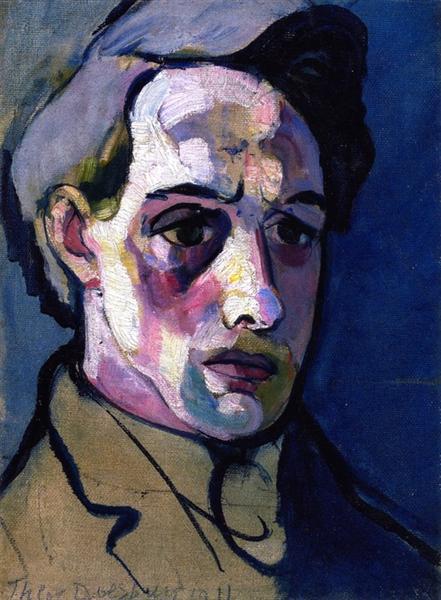Description
In the context of the art of the twentieth century, the 1911 self -portrait of Theo Van Doesburg emerges as a revealing work, encapsulating both the essence of its creator and the principles of Stijl's movement, of which he was a prominent member. Van Doesburg, known for its radical approach and its search for a new aesthetic, presents in this self -portrait a brilliant amalgam of shapes, colors and concepts that challenge the conventional rules of representation.
The work is characterized by its bold use of geometry and color. Instead of offering a physiological representation of the artist, Van Doesburg opts for an image that plays with the plans and lines, emphasizing the relationships between the different visual elements through a compositional scheme that is both dynamic and balanced. The rectangular shape of the canvas is integrated into the composition, where the parts of its face and their clothing break down into simple shapes and primary colors, which are distinctive characteristics of Stijl. In this painting, a palette predominates that includes intense blue, vibrant red and luminous yellow, placed in such a way that they seem to contribute to greater depth, as well as a sense of movement and fluidity.
Through its chromatic choices, Van Doesburg not only portrays its own figure, but invites the viewer to a more extensive reflection on the interaction of color and shape. This approach moves away from the traditional self -portrait, in which the artist seeks a direct emotional connection with the public. Here, the connection is established through formal construction and consideration of space; It is a work that transcends the personal and opens to the dialogue about art itself.
One of the intriguing aspects of this self -portrait is the inclusiveness of the influences of Cubism and the development of a new modern aesthetic. Van Doesburg was immersed in the artistic context of his time, absorbing ideas of contemporaries such as Piet Mondrian and influenced by avant -garde movements that sought to break with the past. In this sense, its self -portrait not only serves as an examination of his identity as an artist, but also as a testimony of his role in the evolution of modern art.
The fact that the self -portrait is full of straight lines and acute angles reinforces the idea that Van Doesburg was not interested solely in external appearance, but rather in the concept of "personality" as something that can be represented through abstractization and visual simplification. Through this work, the dialogue between the shape and color becomes life, with each element formally related to others, creating a synergistic visual experience.
In conclusion, the self -portrait of Theo Van Doesburg of 1911 is erected as a milestone in the representation of the self through modernity, where the lines and colors not only delineate the figure of the artist but also constitute an avant -garde state art itself. At a time where tradition faces innovation, Van Doesburg offers us a reflexive and energetic look at its inner world, while establishing a narrative about the form and color that continues to challenge and inspire contemporary artists. His legacy lasts in this work, which is still the object of admiration and analysis in the discourse of modern art.
KUADROS ©, a famous paint on your wall.
Hand-made oil painting reproductions, with the quality of professional artists and the distinctive seal of KUADROS ©.
Art reproduction service with satisfaction guarantee. If you are not completely satisfied with the replica of your painting, we refund your money 100%.

